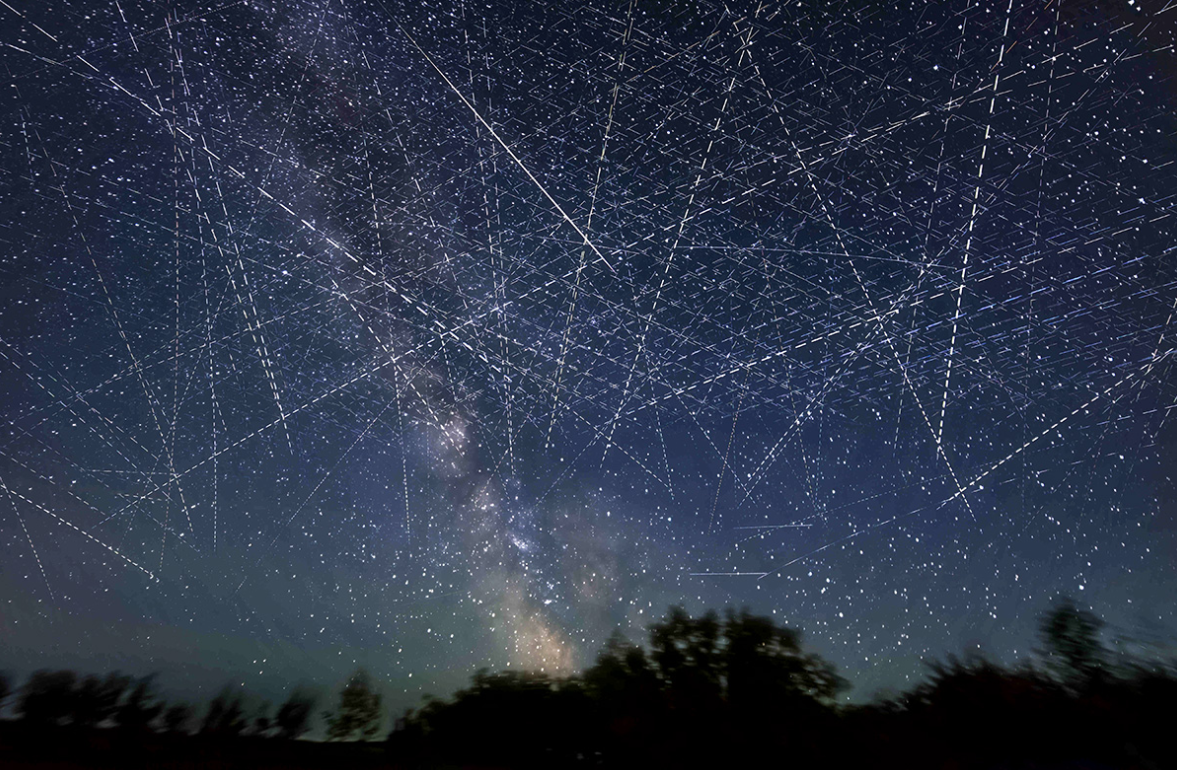
A new study using the Pan-European Radio Telescope Low Frequency Array (LOFAR) has found that leaking radio radiation from SpaceX's Starlink satellites is hampering observations from some ground-based radio telescopes and could eventually "blind" them. The paper was published Sept. 18 in Astronomy & Astrophysics.
More than half of the satellites in orbit are SpaceX Starlink satellites, which can leave light trails in long-exposure images. Photo credit: ALAN DYER/VWPICS VIA REDUX
The LOFAR team reports that SpaceX's second-generation satellites, which began launching last year, send out 30 times more radio waves than the first-generation satellites.
The RF leak was well below the frequency bands Starlink satellites use to provide Internet service to customers and communicate with ground controllers, so the LOFAR team concluded it was unintentional. But it is 10 million times brighter than the dim astronomical sources studied by LOFAR and similar telescopes.
"For radio astronomers, observing when a satellite is in their field of view is like trying to see the faintest star with the naked eye next to a full moon," said Cees Bassa of the Netherlands Institute for Radio Astronomy, which runs LOFAR and is an author of the paper.
The disruption will continue. More than 6,000 Starlink satellites are already in orbit, more than all other operational satellites, and SpaceX plans to build tens of thousands of them. When that happens, a wide-field telescope like LOFAR may not be able to find a patch of sky without a starlink satellite.
"It's like your worst nightmare." "It's kind of frustrating how fast things have gotten," Bassa said.
Researchers at the planned Square Kilometer Array Radio Telescope (SKA) in South Africa and Australia worked closely with SpaceX engineers to reduce radio emissions from early Starlink satellites.
"It's very disappointing to see that the radiation from the latest generation of satellites is still present and brighter," said Phil Diamond, director of the SKA Observatory.
SpaceX is revolutionizing access to space with relatively low-cost, reusable launchers. The company, led by Elon Musk, has successfully built a space Internet business that now has more than 3 million users worldwide.
Other companies are also trying to launch large satellite constellations. Researchers estimate there could be 100,000 satellites in orbit by the end of the 2020s.
Five years ago, optical astronomers realized that low-orbit satellites could reflect sunlight brightly, thus disrupting observations. SpaceX has modified satellites to emit less harsh light, although they have not yet dimmed to levels recommended by the International Astronomical Union.
In 2020, a study by SKA researchers found that radio radiation in the Starlink satellite communications band was leaking into a nearby band reserved for astronomy. Radio astronomers have expressed concern about this, while also winning concessions from SpaceX.
Now, LOFAR has found signals at much lower frequencies, suggesting that something on the satellite is inadvertently acting as an antenna. This radiation covers a wide range of frequencies, overlapping those LOFAR uses to trace the formation of the universe's first galaxies, and even further back to the cosmic "dark ages" before the first stars lit up.The LOFAR researchers also found some brighter satellites that could not be explained by published orbital data. The researchers suspect that they may be military satellite constellations deployed by the US Department of Defense's Star Shield program.
If they are right, the satellites are not as secret as officials believe, and the interference problem may be worse than public satellite data suggests.
SKA researchers have informed SpaceX of the latest results from LOFAR, and the company is conducting its own tests. SKA and SpaceX engineers will meet soon to compare results. "We're happy to help, and hopefully it can be corrected." "Diamond said.
Aaron Boley, an astronomer at the University of British Columbia in Canada, agrees. He wants national regulators to force satellite operators to behave more responsibly because "this is a very big threat to radio astronomy."

